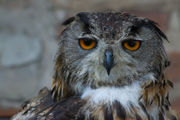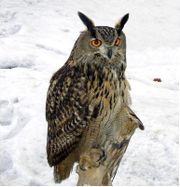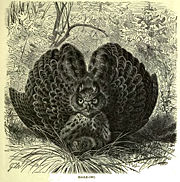Eurasian Eagle-owl
2008/9 Schools Wikipedia Selection. Related subjects: Birds
| Eurasian Eagle Owl | ||||||||||||||
|---|---|---|---|---|---|---|---|---|---|---|---|---|---|---|
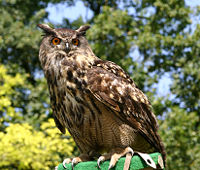 |
||||||||||||||
| Conservation status | ||||||||||||||
|
Least Concern
|
||||||||||||||
| Scientific classification | ||||||||||||||
|
||||||||||||||
| Binomial name | ||||||||||||||
| Bubo bubo (Linnaeus, 1758) |
||||||||||||||
 Range of Eurasian Eagle Owl
|
The Eurasian Eagle Owl (Bubo bubo) is a species of horned owl resident in much of Europe and Asia.
Characteristics
The Eagle Owl is a large and powerful bird, smaller than the Golden Eagle but larger than the Snowy Owl. It has a wingspan of up to 200 cm (5-7 feet). Adult females can weigh in excess of 4 kg (9 lb), in comparison the common Barn Owl weighs about 500 grams (1.1 lb). It mainly feeds on small mammals, but can kill prey up to the size of foxes and young deer (up to 10 kg/22 lb), if taken by surprise. Larger prey (over 3 kg/7 lb) is consumed on the ground which leaves the bird vulnerable (for example to other foxes).
The call of the Eagle Owl is a deep resonant “ooh-hu” with emphasis on the first syllable for the male, and a more high-pitched uh-Hu for the female (in German, the name of this bird is "Uhu"). Each member of an Eagle Owl population can be identified by means of its vocalizations.
The size, ear tufts and orange eyes make this a distinctive species. It has a strong direct flight. The difference between the male and female is that male's ear tufts are more upright than the female's.
The horned owls are a part of the larger grouping of owls known as the typical owls, Strigidae, which contains most species of owl. The other grouping is the barn owls, Tytonidae.
Habitat
The Eagle Owl is largely nocturnal and is found in mountains and forests with cliffs and rocky areas, usually nesting on cliff ledges. They live for around 20 years although like many other bird species in captivity they can live much longer, perhaps up to 60 years.
Although Eagle Owls are usually considered to be a bird of the great wilderness, they have been observed hunting vermin on open landfills in Northern Europe. This poses a certain risk for the owls as any pollutants the rats they feed on have ingested may be enriched in the owls. Eagle Owls that hunt on landfills have also sometimes been seen flying with waste entangled around their feet.
Eagle Owls have also been observed living in European cities. Since 2005, at least five couples have nested in Helsinki. The number is expected to increase due to the growth of a wild rabbit population in Helsinki, most likely originating from released pet rabbits. In June 2007, an Eagle Owl nick-named 'Bubi' landed in the crowded Helsinki Olympic Stadium during the European Football Championship qualification match between Finland and Belgium. The match was interrupted for six minutes. After tiring of the match, following Jonathan Johansson's opening goal for Finland, the bird left the stadium. Finland's national football team have had the nickname Huuhkajat (Finnish for Eurasian Eagle-owls) ever since. The owl was named "Helsinki Citizen of the Year" in December 2007.
Recent UK breeding
The Eagle Owl was not considered to be naturally resident in England, but according to a BBC TV programme (2005), a pair bred for several years in a valley in Ministry of Defence land in North Yorkshire. There was some debate as to whether these birds were escapees or whether they have arrived naturally from the continent, which would only be a short journey from either France or Scandinavia. At the time the program was made, they had reared 20 young to independence, and three young were in the nest. Nothing was known of what happened to those 20 young, except that one of them electrocuted itself on power lines in Shropshire.
Another bird has been sighted several times in Heaton, Bolton, Lancashire. This bird was reported to have died in mid April 2007 due to secondary poisoning, perhaps from eating a contaminated dead rodent. The BBC reported a pair nesting and aggressively protecting their brood from dog-walkers on a nearby footpath in Lancashire, England, in late May 2007.
However, a more recent BBC TV programme (2007) reported that the Eagle Owl is becoming more common in the UK and is showing signs that it is becoming established, mirroring the recent rapid increase in the Buzzard population with which it shares some similarities, particularly prey and habitat.
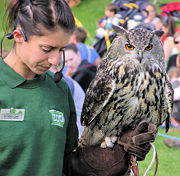
The recent apparent increase in successful wild-breeding has attracted opposition from those who believe the owl to be a danger to native species and young livestock. Perhaps as a result, a few 'new' Eagle Owls have been illegally killed, including the female in North Yorkshire that had successfully reared 23 young, who was shot dead in January 2006. This act was condemned as "disgraceful" by the World Owl Trust.
A new pair in Bowland, Lancashire, have been attracting public attention due to having successfully reared three young to flight. There have also been reports of a further two pairs active in the local area as well as another pair breeding chicks in Northumberland in 2005.
Eagle Owls have also been confirmed breeding in Scotland, with sightings of wild birds confirmed in Galloway, Invernesshire, and Sutherland. The World Owl Trust now believes that the Eagle Owl should be added to the British Ornithologists Union's list of official British birds - indicating the significance of the increase in wild pairs in Britain.
In popular culture
The Malfoy family owl in the Harry Potter series is a Eurasian Eagle-owl.
